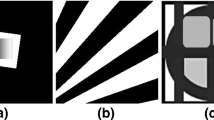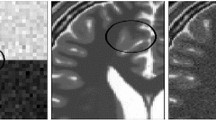Abstract
This chapter focuses on the development of novel image enhancement and robust edge detection methods for practical medical image processing. It is known that the popular transformation-domain shrinkage approach for image enhancement applies a fixed mathematical basis to transform all images to be processed for noise or artifact reduction. However it is not adaptable to processed images, and then easily leads to blurring in the enhanced images. On the other hand, the techniques that are commonly used for edge detection are known as gradient and Laplacian operators (or mask), and smoothed gradient masks are typically used for edge detection in noisy images. However, these methods share a common major drawback wherein the associated masks are always fixed irrespective of the noise level in the images. In this study, we propose a novel learning-based method to adaptively deduce the transforming basis or masks from the processing data for medical image enhancement and robust edge detection. By using independent component analysis (ICA), the proposed learning-based method can extract suitable basis functions or masks for image transformation for processing data, which are adaptable to both the processed image and related noise in the image. The efficiency of the proposed learning-based method for medical image enhancement and edge detection is demonstrated experimentally using positron emission tomography (PET) and magnetic resonance imaging (MRI) medical images.
Access this chapter
Tax calculation will be finalised at checkout
Purchases are for personal use only
Similar content being viewed by others
References
Dhawan PA (2003) Medical imaging analysis. Wiley, Hoboken, NJ
Freiherr G (2010) Waste not. want not: Getting the most from imaging procedures. Diagnostic Imaging, 2010
Defrise M, Kinahan P (1998) Data acquisition and image reconstruction for 3D PET. In: Bendriem B, Townsend DW (eds) The theory and practice of 3D PET. Kluwer Academic, Amsterdam, pp 11–53
Hohne KH, Fuchs H, Pizer SM (2001) Advanced algorithmic approaches to medical image segmentation: state-of-the-art applications in cardiology, neurology, mammography and pathology. Springer, New York
Belaid LJ, Jaoua M, Masmoudi M, Siala L (2005) Image restoration and edge detections by topological asyptotic expansion. Masmoudi personal communication
Malladi R, Sethian JA (1997) Level set methods for curvature flow, image enhancement, and shape recovery in medical images. In: Conference on Visualization and Mathematics, Springer, Berlin, Heidelberg, pp 329–345
Suzuki K, Horiba I, Sugie N (2002) Efficient approximation of a neural filter for quantum noise removal in X-ray images. IEEE Trans Signal Process 50(7):1787–1799
Suzuki K (2009) A supervised “lesion-enhancement” filter by use of a massive-training artificial neural network (MTANN) in computer-aided diagnosis (CAD). Phys Med Biol 54(18):S31–45
Suzuki K, Horiba I, Sugie N, Nanki M (2004) Extraction of left ventricular contours from left ventriculograms by means of a neural edge detector. IEEE Trans Med Imag 23(3):330–339
Suzuki K, Horiba I, Sugie N (2003) Neural edge enhancer for supervised edge enhancement from noisy images. IEEE Trans Pattern Anal Mach Intell 25(12):1582–1596
Canny J (1987) A Computational approach to edge detection. IEEE Trans Pattern Anal Mach Intell 8(6):679–698
Haralick RM (1984) Digital step edges from zero crossings of the second directional derivative. IEEE Trans Pattern Anal Mach Intell 6(1):58–68
Pratt WK (1978) Digital image processing. Wiley, New York
Bell AJ, Sejnowski TJ (1997) The “Independent Components” of natural scenes are edge filters. Vis Res 37:3327–3338.
Bell AJ, Sejnowski TJ (1995) An information-maximization approach to blind separation and blind deconvolution. Neural Comput 7:1129–1159
Common P (1994) Independent component analysis: a new concept? Signal Process 36:287–314
Hyvarinen A, Oja E (1997) A fast fixed-point algorithm for indepepndent component analysis. Neural Comput 9:1483–1492
Hyvarinen A, Oja E, Hoyer P (2000) Image denoising by sparse code shrinkage. In: Haykin S, Kosko B (eds) Intelligent signal processing. IEEE Press, New York
Hoyer P (1999) Independent component analysis in image denoising. Master’s Thesis, Helsinki University of Techonology
Hyvarinen A (1999) Sparse code shrinkage: Denoising of nongaussian data by maximum liklihood estimation. Neural Comput 11(7):1739–1768
Han X-H, Chen Y-W, Nakao Z (2003) An ICA-based method for Poisson noise reduction. Lecture Notes in Artificial Intelligence, vol 2773. Springer, Heidelberg, pp 1449–1454
Han X-H, Nakao Z, Chen Y-W (2005) An ICA-domain shrinkage based Poisson-noise reduction algorithm and its application to penumbral imaging. IEICE Trans Info Syst E88-D(4):750–757
Han X-H, Chen Y-W, Nakao Z (2004) Robust edge detection by independent component analysis in noisy images. IEICE Trans Info Syst vol.E87-D(9):2204–2211
Han X-H, Nakao Z, Chen Y-W (2006) An edge extraction algorithm based ICA-domain shrinkage for penumbral imaging. Information 9(3):529–544
Colsher JG (1980) Fully three-dimensional positron emission tomography. Phys Med Biol 25:103–115
Defrise M, Townsend DW, Deconinck F (1990) Statistical noise in three-dimensional positron tomography. Phys Med Biol 35:131–138
Ito Y (1988) Poisson analysis and statistical mechanics. Probab Theor Relat Field 77:1–28
Donoho DL (1995) De-noising by soft-thresholding. IEEE Trans Inform Theor 41(3):613–6275
Atkins MS, Mackiewich BT (2000) Processing and analysis. Handbook of medical imaging. Academic Press, Orlando, Chap 11, pp 171–183
Chalana V, Kim Y (1997) A methodology for evaluation of boundary detection algorithms on medical images. IEEE Trans Med Imag 16(5):642–652.
Olshausen BA, Field DJ (1996) Emergence of simple-cell receptive field properties by learning a sparse code for natural images. Nature 381:607–609
Julius O. Smith III JO (2003) Mathematics of the discrete fourier transform (DFT). W3K Publishing, http://www.w3k.org/books/. ISBN 0-9745607-0-7.
Karvanen J, Cichocki A (2003) Measuring sparseness in noisy signals. Proceedings of ICA 2003, Nara, Japan, pp 125–130
Reza AM (2004) Realization of the contrast limited adaptive histogram equalization (CLAHE) for real-time image enhancement. J VLSI Signal Process 33(1):35–44
Acknowledgments
This work was supported in part by the Grant-in Aid for Scientific Research from the Japanese MEXT under the Grant No. 2430076, 24103710, 24700179 and in part by the R-GIRO Research fund from Ritsumeikan University. We would also like to thank our co-operating researchers: Keishi Kitamura, Akihiro Ishikawa, Yoshihiro Inoue, Kouichi Shibata, Yukio Mishina and Yoshihiro Mukutaof of Shimadzu Corporation, for providing PET data and valuable discussion.
Author information
Authors and Affiliations
Corresponding author
Editor information
Editors and Affiliations
Rights and permissions
Copyright information
© 2014 Springer Science+Business Media New York
About this chapter
Cite this chapter
Han, XH., Chen, YW. (2014). Adaptive Noise Reduction and Edge Enhancement in Medical Images by Using ICA. In: Suzuki, K. (eds) Computational Intelligence in Biomedical Imaging. Springer, New York, NY. https://doi.org/10.1007/978-1-4614-7245-2_13
Download citation
DOI: https://doi.org/10.1007/978-1-4614-7245-2_13
Published:
Publisher Name: Springer, New York, NY
Print ISBN: 978-1-4614-7244-5
Online ISBN: 978-1-4614-7245-2
eBook Packages: EngineeringEngineering (R0)




